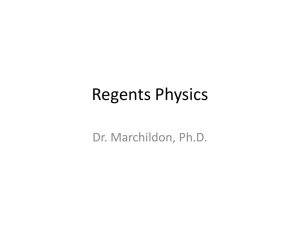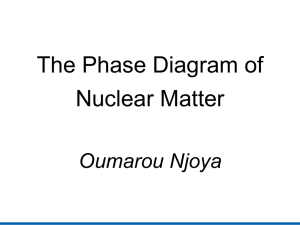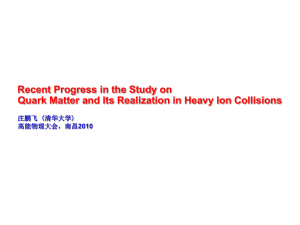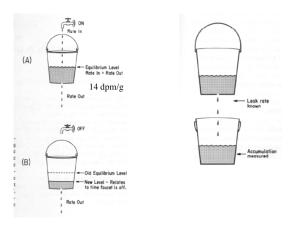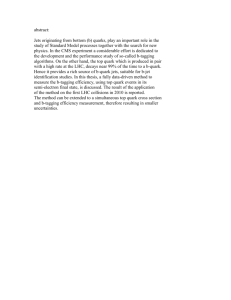Document
advertisement
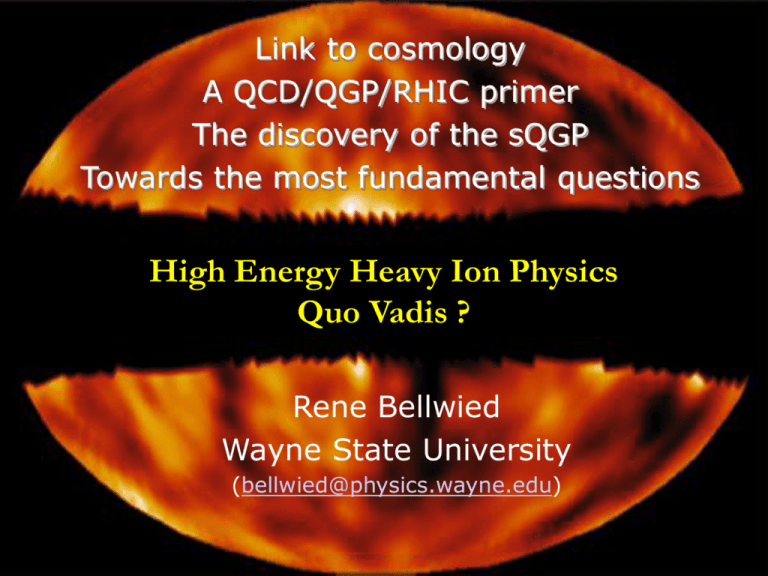
Link to cosmology A QCD/QGP/RHIC primer The discovery of the sQGP Towards the most fundamental questions High Energy Heavy Ion Physics Quo Vadis ? Rene Bellwied Wayne State University (bellwied@physics.wayne.edu) Motivation for Relativistic Heavy Ion Collisions Two big connections: cosmology and QCD Going back in time… Age 0 10-35 s Energy 1019 GeV 1014 GeV Matter in universe grand unified theory of all forces 1st phase transition (strong: q,g + electroweak: g, l,n) 10-10 s 102 GeV 2nd phase transition (strong: q,g + electro: g + weak: l,n) 10-5 s 0.2 GeV 3 min. 0.1 MeV RIA & FAIR RHIC, LHC &(strong:hadrons FAIR + electro:g + weak: l,n) 6*105 years 0.3 eV Now (15 billion years) 3rd phase transition 3*10-4 eV = 3 K nuclei atoms Evolution of Forces in Nature Connection to Cosmology • Baryogenesis ? Separation of Matter and Antimatter – can it happen at the phase transition ? • Dark Matter Formation ? – can it happen at the phase transition ? • Dark Energy Formation – can it happen at the phase transition ? • Is matter generation in cosmic medium (plasma) different than matter generation in vacuum ? • Can fluctuations at the phase transition explain an anisotropic matter distribution in the universe ? Sakharov (1967) – three conditions for baryogenesis • Baryon number violation • C- and CP-symmetry violation • Interactions out of thermal equilibrium • Currently, there is no experimental evidence of particle interactions where the conservation of baryon number is broken: all observed particle reactions have equal baryon number before and after. Mathematically, the commutator of the baryon number quantum operator with the Standard Model Hamiltonian is zero: [B,H] = BH - HB = 0. This suggests physics beyond the Standard Model • The second condition — violation of CP-symmetry — was discovered in 1964 (direct CP-violation, that is violation of CP-symmetry in a decay process, was discovered later, in 1999). If CPT-symmetry is assumed, violation of CP-symmetry demands violation of time inversion symmetry, or T-symmetry. Under investigation • The last condition states that the rate of a reaction which generates baryon-asymmetry must be less than the rate of expansion of the universe. In this situation the particles and their corresponding antiparticles do not achieve thermal equilibrium due to rapid expansion decreasing the occurrence of pair-annihilation. A mass problem of universal proportion • The stars and gas in most galaxies move much quicker than expected from the luminosity of the galaxies. • In spiral galaxies, the rotation curve remains at about the same value at great distances from the center (it is said to be ``flat''). • This means that the enclosed mass continues to increase even though the amount of visible, luminous matter falls off at large distances from the center. Something else must be adding to the gravity of the galaxies without shining. We call it Dark Matter ! According to measurements it accounts for > 80% of the mass in the universe. The cosmic connection of RHI physics Witten’s ‘Cosmic Separation of phases’ (Phys.Rev.D 30 (1984) 272) basic parameter: mass Originally: strange quark matter was a prime candidate for dark matter (as recent as SQM 2003) Dark Matter vs. Luminous Matter distribution Bullet Cluster, 3.4 Billion Lightyears from Earth X-ray image vs. gravitational lensing The universe is accelerating…. Based on supernovae measurements You need DARK ENERGY as an explanation (!?) Dark Energy does not kick in at the time of the Big Bang ! The cosmic connection of RHI physics Let’s understand mass generation in the luminous matter What do we know about quark masses ? Why are quark current masses so different ? There is no answer to this questions. There likely will be no answer to this question ! Nature’s constants: -speed of light, electric charge, quark current masses (?) Very little is known, very little can be explained Standard model is symmetric All degrees of freedom are massless Electro-weak symmetry breaking via Higgs field (Dm of W, Z, g) Mechanism to generate current quark masses (but does not explain their magnitude) Chiral symmetry breaking via dynamical quarks Mechanism to generate constituent quark masses (but does not explain hadronization) We can’t answer the question of mass generation at the most fundamental level, but can we answer the question of mass generation at the nuclear level ? Theory: Quantum Chromo Dynamics The fundamental problem: how is baryonic mass generated Based on quark interactions (5+10+10 = 935 MeV/c2) ? Theoretical and computational (lattice) QCD In vacuum: - asymptotically free quarks have current mass - confined quarks have constituent mass - baryonic mass is sum of valence quark constituent masses Masses can be computed as a function of the evolving coupling strength or the ‘level of asymptotic freedom’, i.e. dynamic masses. But the universe was not a vacuum at the time of hadronization, it was likely a plasma of quarks and gluons. Is the mass generation mechanism the same ? The main features of Quantum Chromodynamics (QCD) • Confinement – At large distances the effective coupling between quarks is large, resulting in confinement. – Free quarks are not observed in nature. • Asymptotic freedom – At short distances the effective coupling between quarks decreases logarithmically. – Under such conditions quarks and gluons appear to be quasi-free. • (Hidden) chiral symmetry – Connected with the quark masses – When confined quarks have a large dynamical mass - constituent mass – In the small coupling limit (some) quarks have small mass - current mass Analogies and differences between QED and QCD to study structure of an atom… electron …separate constituents nucleus Imagine our understanding of atoms or QED if we could not isolate charged objects!! neutral atom ToConfinement: understandfundamental the strong force and the phenomenon of confinement: & crucial (but not understood!) feature of strong force - colored objects (quarks) have energy in normal vacuum Create and study a system of deconfined colored quarks (and gluons) quark-antiquark pair created from vacuum quark “white” proton (confined quarks) Strong color field “white” 0 “white” proton Force grows with separation(confined !!! quarks) A mechanism of hadronization in vacuum: String Fragmentation High momentum current mass quark pair forms flux tube in a collision = string of energy (string tension) i.e. dynamical quark field which fragments into hadrons when string tension becomes too large. Describes e+e- and p-pbar and p-p collisions well. Hadronization in medium (i.e. during universe expansion) could be different because medium might affect the mechanism. The temperature dependent running coupling constant as and its effect on mass generation above Tc O.Kaczmarek et al. (thermal mass, LQCD) (hep-lat/0406036) 1.05 Tc 1.5 Tc 3 Tc 12 Tc 6 Tc in an expanding system: interplay between distance and temperature Massive partons above Tc e.g. P.Levai and U.Heinz (hep-ph/9710463) Lattice QCD: Chiral Symmetry is restored at Tc One goal: Proving asymptotic freedom in the laboratory. Nobel Prize 2005 D. Gross H.D. Politzer F. Wilczek QCD Asymptotic Freedom (1973) • Measure deconfinement and chiral symmetry restoration under the conditions of maximum particle or energy density. Before QCD Density of hadron mass states dN/dM increases exponentially with mass. dN ~ exp M TH dM TH ~ 21012 oK Broniowski, et.al. 2004 Energy diverges as T --> TH Rolf Hagedorn German Hadron bootstrap model and limiting temperature (1965) Maximum achievable temperature? “…a veil, obscuring our view of the very beginning.” Steven Weinberg, The First Three Minutes (1977) QCD to the rescue! Replace Hadrons (messy and numerous) “In 1972 the early universe seemed hopelessly opaque…conditions of ultrahigh temperatures…produce a theoretically intractable mess. But asymptotic freedom renders ultrahigh temperatures friendly…” Frank Wilczek, Nobel Lecture (RMP 05) e/T4 g*S Thermal QCD ”QGP” Hadron gas by Quarks and Gluons (simple and few) (Lattice) Karsch, Redlich, Tawfik, Eur.Phys.J.C29:549-556,2003 Nobel prize for Physics 2005 e+e- Annihilation Nucleosynthesis Mesons freeze out QCD Transition Heavy quarks and bosons freeze out Thermal QCD -i.e. quarks and gluons -- makes the very early universe tractable; but where is the experimental proof? g*S n Decoupling “Before [QCD] we could not go back further than 200,000 years after the Big Bang. Today…since QCD simplifies at high energy, we can extrapolate to very early times when nucleons melted…to form a quark-gluon plasma.” David Gross, Nobel Lecture (RMP 05) Kolb & Turner, “The Early Universe” Generating a deconfined state Present understanding of Quantum Chromodynamics (QCD) • heating • compression deconfined color matter ! Hadronic Nuclear Matter Matter Quark Gluon Plasma (confined)! deconfined Expectations from Lattice QCD e/T4 ~ # degrees of freedom confined: few d.o.f. deconfined: many d.o.f. TC ≈ 173 MeV ≈ 21012 K ≈ 130,000T[Sun’s core] eC 0.7 GeV/fm3 Suggested Reading • October 2006 issue of Nature: “Did the Big Bang Boil ? ” by F. Wilczek • …the answer as far as the quarkhadron transition is concerned is ‘No’. QCD evolves smoothly with temperature there is no thermodynamic phase transition. • Heavy Ion collisions at RHIC and the LHC can produce fireballs with a significant excess of baryons over anti-baryons, or different effective temperatures for quarks and gluons – possibilities that did not occur in the cosmic Big Bang. In those new circumstances do true phase transitions occur ? A phase transition into what ? • With the liquid-gas phase transition established (ground state liquid drop nuclei transition to a hadron gas) the question was: What comes next ? A weakly interacting plasma. • Edward Shuryak (1971) : name it the Quark Gluon Plasma Cabibo-Parisi, PLB59 (1975) G.Baym, NSAC-LRP (1983) The phase diagram of QCD Temperature Early universe critical point ? quark-gluon plasma Tc colour superconductor hadron gas nucleon gas nuclei CFL r0 vacuum baryon density Neutron stars Study all phases of a heavy ion collision If the QGP was formed, it will only live for 10-22 s !!!! BUT does matter come out of this phase the same way it went in ??? microexplosions femtoexplosions s 0.1 J 1 J e 1017 J/m3 5 GeV/fm3 = 1036 J/m3 T 106 K 200 MeV = 1012 K rate 1018 K/s 1035 K/s Energy density of matter high energy density: e > 1011 J/m3 P > 1 Mbar I > 3 X 1015W/cm2 Fields > 500 Tesla QGP energy density e > 1 GeV/fm3 i.e. > 1030 J/cm3 Step 1: Measuring a reference system In order to prove that we form a phase of matter that behaves different than the vacuum we need to understand our results in pp collisions ? Hadronization in QCD (the factorization theorem) Jet: A localized collection of hadrons which come from a fragmenting parton hadrons c a Parton Distribution Functions Hard-scattering cross-section b d hadrons Fragmentation Function leading particle High pT (>~ 2.0 GeV/c) hadron production in pp collisions: h d pp 0 D d 2 2 h/c K dx dx f ( x , Q ) f ( x , Q ) ( ab cd ) a b a a b b 2 dyd pT dtˆ zc abcd “Collinear factorization” 0 in pp: well described by NLO (& LO) p+p->0 + X Thermallyshaped Soft Production “Well Calibrated” Hard Scattering • Ingredients (via KKP or Kretzer) – pQCD – Parton distribution functions – Fragmentation functions • ..or simply PYTHIA… hep-ex/0305013 S.S. Adler et al. pp at RHIC: Strangeness formation in QCD nucl-ex/0607033 How strong are the NLO corrections in LO calculations (PYTHIA) ? • K.Eskola et al. (NPA 713 (2003)): Large NLO corrections not unreasonable at RHIC energies. Should be negligible at LHC (5.5 or 14 TeV). STAR LHC New NLO calculation based on STAR data (AKK, hep-ph/0502188, Nucl.Phys.B734 (2006)) K0s apparent Einc dependence of separated quark contributions. Mt scaling in pp Breakdown of mT scaling in pp ? mT slopes from PYTHIA 6.3 Gluon dominance at RHIC PYTHIA: Di-quark structures in baryon production cause mt-shift Recombination: 2 vs 3 quark structure causes mt shift Collision Energy dependence of baryon/meson ratio - baryon production in pp is simply not well understood Ratio vs pT seems very energy dependent (RHIC < < SPS or FNAL), LHC ? Not described by fragmentation ! (PYTHIA ratios at RHIC and FNAL are equal) Additional increase with system size in AA Both effects (energy and system size dependence) well described by recombination Conclusions for RHIC pp data • We are mapping out fragmentation and hadronization in vacuum as a function of flavor. • What we have learned: – Strong NLO contribution to fragmentation even for light quarks at RHIC energies – Quark separation in fragmentation function very important. Significant nonvalence quarks contribution in particular to baryon production. – Gluon dominance at RHIC energies measured through breakdown of mt-scaling and baryon/meson ratio. Unexpected small effect on baryon/antibaryon ratio – Is there a way to distinguish between fragmentation and recombination ? Does it matter ? • What will happen at the LHC ? What has happened in AA collisions (hadronization in matter) ? The future: unprecedented physics reach at LHC (ALICE – pp) (charged particle spectra) enormous reach in multiplicity and transverse momentum. Could this system behave collectively ?? Step 2: Proving the existence of a new phase of matter Can we prove that we have a phase that behaves different than elementary pp collisions ? Three steps: a.) prove that the phase is partonic b.) prove that the phase is collective c.) prove that the phase characteristics are different from the QCD vacuum Fate of jets in heavy ion collisions? idea: p+p collisions @ same sNN = 200 GeV as reference p p ?: what happens in Au+Au to jets which pass through medium? Prediction: scattered quarks radiate energy (~ GeV/fm) in the colored medium: “quenches” high pT particles “kills” jet partner on other side ? Au+Au Major discoveries in AuAu collisions ‘The Big Three’ (leading to the discovery of the sQGP = the Perfect Quark Gluon Liquid = AIP Science Story of 2005) # I: The medium is dense and partonic STAR, nucl-ex/0305015 pQCD + Shadowing + Cronin energy loss pQCD + Shadowing + Cronin + Energy Loss Deduced initial gluon density at t0 = 0.2 fm/c dNglue/dy ≈ 800-1200 e≈ 15 GeV/fm3, eloss = 15*cold nuclear matter (compared to HERMES eA or RHIC dA) (e.g. X.N. Wang nucl-th/0307036) An important detail: the medium might not be totally opaque There are specific differences to the flavor of the probe Experiment: there are baryon/meson differences Theory: there are two types of e-loss: radiative and collisional, plus dead-cone effect for heavy quarks Flavor dependencies map out the process of in-medium modification # II: The medium behaves like a liquid Strong collective flow: elliptic and radial expansion with mass ordering z y x requires partonic hydrodynamics: strong coupling, small mean free path, lots of interactions NOT plasma-like more like a perfect liquid (near zero viscosity, d.o.f. ?) # III: The medium consists of constituent quarks ? baryons mesons Recombination vs. Fragmentation (a different hadronization mechanism in medium than in vacuum ?) Recombination at moderate PT Parton pt shifts to higher hadron pt. Fragmentation at high PT: Parton pt shifts to lower hadron pT Recomb. fragmenting parton: ph = z p, z<1 recombining partons: p1+p2=ph Frag. plasma liquid ? gas liquid Hirano, Gyulassy (2006) Consequences of a perfect liquid • All “realistic” hydrodynamic calculations for RHIC fluids to date have assumed zero viscosity h= 0 “perfect fluid” – But there is a (conjectured) quantum limit: h 4 ( Entropy Density ) 4 s – Where do “ordinary” fluids sit wrt this limit? – RHIC “fluid” might be at ~2-3 on this scale (!) T=1012 K Description might require new dimensions • Expanding our theoretical tools – the Maldacena conjecture – AdS/CFT for calculating static and dynamic properties of strongly-coupled gauge theories • There is a string dual to AdS/CFT: 4 dim. SUSY Yang-Mills • Determine viscosity and entropy density in RHIC by calculating it in a 10-dim black hole calculation MULTIPLICITY Entropy Black Hole Area c c DISSIPATION Viscosity Graviton Color Screening Absorption Explaining the Connection 1) Weakly Coupled (classical) gravity in Anti-deSitter Space (AdS) 2) Maldacena’s conjecture 3) Strongly Coupled (Conformal) gauge Field Theories (CFT) Suggested Reading • November, 2005 issue of Scientific American “The Illusion of Gravity” by J. Maldacena • A test of this prediction comes from the Relativistic Heavy Ion Collider (RHIC) at BrookhavenNational Laboratory, which has been colliding gold nuclei at very high energies. A preliminary analysis of these experiments indicates the collisions are creating a fluid with very low viscosity. Even though Son and his co-workers studied a simplified version of chromodynamics, they seem to have come up with a property that is shared by the real world. Does this mean that RHIC is creating small fivedimensional black holes? It is really too early to tell, both experimentally and theoretically. (Even if so, there is nothing to fear from these tiny black holes-they evaporate almost as fast as they are formed, and they "live" in five dimensions, not in our own fourdimensional world.) In the past six months: >50 preprints on AdS/CFT ! • “The stress tensor of a quark moving through N=4 thermal plasma”, J.J. Friess et al., hep-th/0607022 Our 4-d world String theorist’s 5-d world The stuff formerly known as QGP Jet modifications from wake field Heavy quark moving through the Energy loss medium from string drag An explosion of new papers based on string duality to AdS/CFT • J.Friess et al., hep-th/0607022 Stress tensor of a quark moving through a N=4 thermal plasma • J.Friess et al., hep-th/0605292 Dissipation from a heavy quark moving through a N=4 super YangMills plasma • Liu, Rajagopal, Wiedemann, hep-th/0607062 An AdS/CFT calculation of screening in a hot wind • Liu, Rajagopal, Wiedemann, hep-th/0605178 Calculating the jet quenching parameter from AdS/CFT The perfect liquid, when does it vaporize ? SU(3) gauge theory (2+1) flavor QCD Resummed perturbative calculations from : Blaizot, Iancu, Rebhan, hep-ph/0303185 Lattice data on pressure and entropy density at high temperatures can be described by re-summed perturbation theory. At high T deviation from SB limit only 10% Comparison with re-summed perturbation theory, effective 3d theory and additional lattice data on quark number susceptibility and the Debye mass suggest that we have wQGP for T > 2 Tc Quo Vadis ? Many very important issues are left to investigate, e.g. a.) need evidence for chiral symmetry restoration b.) what are the initial conditions ? c.) what is the hadronization mechanism in medium and in vacuum ? How are hadronic masses generated ? d.) is there a critical point at finite net baryon density and how do the features of the phases change close to it ? e.) is there a Color Glass Condensate at very low x ? K*-(892) Resonances are: Luis Walter Alvarez 1968 Nobel Prize for “ resonance particles ” discovered 1960 • Excited state of a ground state particle. • With higher mass but same quark content. • Decay strongly short life time (~10-23 seconds = few fm/c ), width = natural spread in energy: = h/t. Breit-Wigner shape 0 2 4 Number of events 10 8 6 Chirality: Why Resonances ? 640 680 720 760 800 840 880 920 Invariant mass (K0+) [MeV/c2] minv E1 E2 )2 p1 p 2 ) 2 K* from K-+p collision system K p K*p K0 • Broad states with finite and t, which can be formed by collisions between the particles into which they decay. Why Resonances?: • Surrounding nuclear medium may change resonance properties • Chiral symmetry breaking: Dropping mass -> width, branching ratio Bubble chamber, Berkeley M. Alston (L.W. Alvarez) et al., Phys. Rev. Lett. 6 (1961) 300. Strange resonances in medium Short life time [fm/c] K* < *< (1520) < 4 < 6 < 13 < 40 Rescattering vs. Regeneration ? Medium effects on resonance and their decay Red: before chemical freeze out products before (inelastic) and after chemical Blue: after chemical freeze out freeze out (elastic). Resonance Signal in Au+Au collisions STAR Preliminary *0 K + K(892) K*0 Au+Au minimum biaspT 0.2 XX *± +*± GeV/c |y| 0.5 (1520) (1020) STAR Preliminary STAR Preliminary Chiral Symmetry Restoration Vacuum At Tc: Chiral Restoration Data: ALEPH Collaboration R. Barate et al. Eur. Phys. J. C4 409 (1998) Measure chiral partners Near critical temperature Tc (e.g. r and a1) a1 r + Ralf Rapp (Texas A&M) J.Phys. G31 (2005) S217S230 Lattice QCD predicts a critical point (critical parameters at finite baryon density) Critical Endpoint in Effective Models Compilation by Stephanov Do we need a color glass condensate to explain experimental puzzle in HEP ? Froissart Bound The Gluon ‘blows up’ RHIC The gluon ‘blows up’ Gluon saturation Gluon density in hadrons Motivation for the CGC A time evolution for ‘matter’ Final phase diagram The reach of RHIC CGC at LHC What are the initial conditions ? – Mid – forward rapidity correlations (hep-ph/0403271) – Direct photons at forward rapidities – gg HBT (coherence of sea-quark source?) – Drell-Yan in forward region (hepph/040321) – RpA, RAA of heavy mesons in forward direction (hepph/0310358) requires tracking, calorimetry and PID over large h-range. ln (1/x) Color Glass Condensate (CGC): gluon saturation at low Q2. Measure Onium physics – the complete program – Melting of quarkonium states (Deconfinement TC) Tdiss(Y’) < Tdiss((3S)) < Tdiss(J/Y) Tdiss((2S)) < Tdiss((1S)) Color screening of heavy flavor will tell us the Initial temperature and its evolution with time ! The initial thermal conditions Requirements for a complete onium program • Full coverage high resolution forward calorimetry in order to measure not only the J/y but also the cc and the Y States Full coverage (|h|< 3) calorimetry and muon absorbers give us up to 1,000,000 cc, 10,000 Y(2s) and 10,000 Y(3s) per RHIC year. The J/y alone is not sufficient ! There is plenty to do… • ..and all of it is exciting • ..and all of it is fundamental • ..and all of it will benefit the understanding of QCD, the standard model, and potentially new physics • ..and all of it will shed light on the evolution of the universe • ..and we might understand the generation of mass, one of the most fundamental principles in nature
